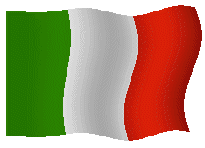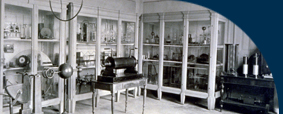 |
Winter's plate electrical machine |
 |
Macchina elettrostatica a disco di Winter |
| Subject: electrostatics/friction generators |
Settore: elettrostatica/generatore a strofinio di elettricità |
| Numbers of catalogue: 313 - 314 |
Numeri di inventario: 313, 314 |
| On the walnut frame: "Achille. Scateni Urbino" [engraved on the brass plaque] |
Sul telaio di noce: "Achille Scateni Urbino" [inciso su placca d'ottone] |
| 1863 [document] |
Periodo di costruzione: 1863 [documento] |
| Walnut, brass, glass, iron, leather |
Materiali utilizzati: Noce, ottone, vetro, ferro, cuoio |
1470 X 260 X 2580 [mm] |
Dimensioni: 1470 X 260 X 2580 [mm] |
| |
|
Including: insulated footstool with glass feet |
Annessi: sgabello in noce con piedini isolanti in vetro |
| |
|
Accessories: two Henly electrometers (identical), electric point, two electric whirls (see figure n. 61). |
Accessori: due elettrometri di Henly (identici), punta per l'esperienza del soffio, due arganetti elettrici (vedi la figura n. 61) |
| |
|
From a surviving hand-written letter it is evident that this great friction electrostatic generator was made in 1863 by the laboratory mechanic Achille Scateni. He reproduced it from the model projected towards the half of the 19th century by the maker of electric machines Carl Winter from Vienna. This model is very similar to the one suggested by the French electrician J.B Le Roy in 1772. Winter's machine is noted, first of all, for the great dimension of the glass plate which, when increasing the distance between the bearings and the collectors, reduced the effects of the discharge to a minimum, and, secondly, for the introduction of large "ring inductors" in the primary and secondary conductors. The ring inductors were generally made of wood and each of them had a metal wire inside that was linked to the base of its corresponding conductor. According to the ideas of that time, they functioned as condensers (the wooden ring was meant as a dielectric placed between the metal wire and the "atmospheric electricity") and they were intended to increase the power and the length of the sparks produced. Actually, only the geometric capacity of the conductors was increased. This type of machine became relatively popular in Italian scientific laboratories in the second half of the 18th century. |
Da una lettera manoscritta sappiamo che questo grande generatore elettrostatico a strofinio fu materialmente costruito nel 1863 dal meccanico di laboratorio Achille Scateni. Egli la riprodusse sul modello ideato verso la metà del XIX secolo dal costruttore di macchine elettriche viennese Carl Winter. Questo modello è molto simile a quello che aveva proposto l'elettricista francese J. B. Le Roy nel 1772. La macchina di Winter si caratterizza per le notevoli dimensioni del piatto di vetro che, aumentando la distanza tra cuscinetti e collettori, minimizzava gli effetti di scarica e per l'aggiunta nei conduttori primario e secondario di grandi "induttori ad anello". Questi ultimi erano generalmente di legno ed avevano all'interno un filo metallico che si ricongiungeva alla base dei rispettivi conduttori. Secondo le idee del tempo essi avevano l'ufficio di condensatori (l'anello di legno era pensato come un dielettrico interposto tra il filo metallico e "l'elettricità atmosferica") e dovevano servire ad aumentare la potenza e la lunghezza delle scintille prodotte. In realtà era la sola capacità geometrica dei conduttori ad essere aumentata. Questa tipo di macchina ebbe nella seconda metà del XIX secolo una discreta diffusione nei laboratori scientifici della penisola italiana |
| |
|
Description: The machine is fitted onto a big and robust walnut base which is supported by four small feet. A vertical glass disk (( = 710 mm, not original) is rotated by a crank that controls an horizontal iron shaft supported by two walnut feet. The disk rotates between a pair of bearings (upholstered with alternated layers of soft flannel and covered with leather) and two metal combs in the form of a ring the points of which are in the direction of the disk: the bearings are glued to walnut frames which can be inserted (by making them slide) into an elastic metal vise provided with pressure screws that allow for the change of adhesion of the bearings to the glass disk. The surface of the bearings has some traces of Kienmeier's amalgam (an alloy formed by stannum, zinc and mercury). A glass column insulates and supports the bearings. These are connected to a brass conductor (the secondary conductor) that is linked, in turn, to a small brass chain, which, if placed upon the ground, dissipates the negative charges created by friction. The metal combs are connected with a big brass sphere (the primary collector) which has, on its lateral extension, a second brass sphere (smaller and with a hole for the insertion of Henley's electrometer) and a hole on its upper surface for the introduction of a big brass ring ( = 66 cm). |
Descrizione: la macchina è montata su un grande e robusto basamento in noce sorretto da quattro piedini. Un disco di vetro verticale (Ø = 710 mm, non originale) è messo in rotazione da una manovella che comanda un asse orizzontale in ferro sostenuto da due sostegni in noce. Il disco ruota tra una coppia di cuscinetti (imbottiti da più strati alternati di morbida flanella e coperti di cuoio) e due pettini metallici ad anello aventi le punte rivolte verso il disco. I cuscinetti sono incollati a telai di noce che si innestano a slitta su una morsa elastica metallica, dotata di viti che a pressione permettono di variare l'aderenza dei cuscinetti al disco di vetro. La superficie dei cuscinetti presenta tracce dell'amalgama di Kienmeier (una lega formata da parti di stagno, zinco e mercurio). Una colonna di vetro provvede ad isolare e sostenere i cuscinetti. Questi sono in comunicazione con un conduttore d'ottone (il secondario) connesso ad una catenella, pure d'ottone, che messa a terra fa disperdere le cariche negative accumulate per strofinio. I pettini metallici comunicano con una grande sfera d'ottone (collettore primario) avente sul prolungamento laterale una seconda sfera d'ottone (più piccola, dotata di un foro per l'adattamento dell'elettrometro di Henley) e sulla sua sommità un foro per l'innesto di un grande anello (Ø = 66 cm) d'ottone. |
| |
|
Function: By rotating the disk with the crank, the disk is electrified with a positive charge due to the friction of the bearings. The bearings are then negatively electrified and they continuously charge and discharge the secondary conductor to the ground through the small chain. The positive charges go from the disk towards the combs, which are negatively charged by induction: in this way the positive charges that are continuously recreated by the friction of the bearings are neutralized; at the same time the primary collector is positively charged. |
Funzionamento: ruotando con la manovella il disco questo si elettrizza positivamente per lo strofinio dei cuscinetti che a loro volta si elettrizzano negativamente caricando e scaricando continuamente a terra il conduttore secondario tramite la catenella. Le cariche positive vengono trasportate dal disco in vicinanza dei pettini che per induzione si caricano negativamente neutralizzando in parte le cariche positive che vengono continuamente ripristinate dallo sfregamento dei cuscinetti; contemporaneamente il collettore primario si carica positivamente. |
| |
|
Bibliography: Ferguson [1873], pp. 75-79; Marco [1883], vol. II, pp. 79-80; Jamin [1890], tome quatrième (partie I), p. 370-371. |
Bibliografia: Ferguson [1873], pp. 75-79; Marco [1883], Vol. II, pp. 79-80; Jamin [1890], tome quatrième (partie I), p. 370-371
|

